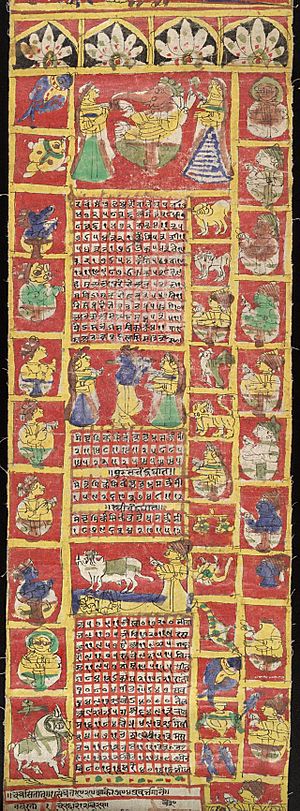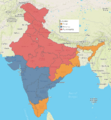Hindu calendar facts for kids
The Hindu calendar is a special way of keeping track of time that people in India have used for thousands of years. It's a bit different from the calendar most of the world uses today because it follows both the Sun and the Moon. This type of calendar is called a lunisolar calendar. Over time, different parts of India developed their own versions, so today there are several regional Hindu calendars, along with a national calendar for the whole country.
Contents
Understanding the Hindu Calendar
The Hindu calendar is one of the oldest ways to organize time. It helps people know when to celebrate important festivals and when to plant crops. Unlike the calendar many of us use, which mostly follows the Sun, the Hindu calendar pays attention to both the Sun and the Moon. This makes it a very unique system.
How a Lunisolar Calendar Works
A lunisolar calendar combines two cycles: the Earth going around the Sun (which makes a year) and the Moon going around the Earth (which makes a month).
- Solar Year: This is how long it takes for the Earth to complete one trip around the Sun, which is about 365 days.
- Lunar Month: This is how long it takes for the Moon to go through all its phases, from new moon to new moon, which is about 29.5 days.
Because 12 lunar months (about 354 days) are shorter than a solar year (365 days), the Hindu calendar adds an extra month every few years. This extra month, called an Adhik Maas, helps keep the lunar months aligned with the seasons and the solar year. It's like adding a leap month to catch up!
Months and Seasons in the Hindu Calendar
The Hindu calendar has 12 lunar months, and each month starts with a new moon or a full moon, depending on the region. These months are often named after stars or constellations that are visible in the sky during that time. Some common month names include:
- Chaitra
- Vaishakha
- Jyeshtha
- Ashadha
- Shravana
- Bhadrapada
- Ashwin
- Kartika
- Margashirsha
- Pausha
- Magha
- Phalguna
Each month is divided into two halves, called pakshas. One half is when the Moon is getting bigger (waxing), and the other is when it's getting smaller (waning). The calendar also links specific seasons to certain months, helping farmers know when to plant and harvest.
Why Are There Different Hindu Calendars?
Over many centuries, different parts of India developed their own ways of using the Hindu calendar. This is why you might hear about different regional calendars, like the Vikram Samvat, Saka Samvat, or Bengali Calendar.
- Regional Variations: These calendars might start their new year on different dates or use slightly different calculations for the months.
- Local Traditions: Each region has its own unique traditions and festivals, and their calendar helps keep track of these important dates.
Even with these differences, the basic idea of following both the Sun and the Moon remains the same across all Hindu calendars.
Celebrating with the Hindu Calendar
The Hindu calendar is very important for celebrating many festivals throughout the year. Festivals like Diwali, Holi, and Navaratri are all determined by the Hindu calendar.
- Festival Dates: Because the calendar is lunisolar, the dates of these festivals change each year when compared to the calendar most of the world uses. For example, Diwali always falls on the darkest night of the month of Kartika.
- Cultural Importance: The calendar helps people connect with their culture, traditions, and religious practices. It guides daily life, ceremonies, and even astrology.
Images for kids
-
The Hindu calendar saka samvat system is found in Indonesian inscriptions, such as the Kedukan Bukit inscription (pictured above) dated to 604 Śaka, which is equivalent to 682 CE.
See also
 In Spanish: Calendario hindú para niños
In Spanish: Calendario hindú para niños




